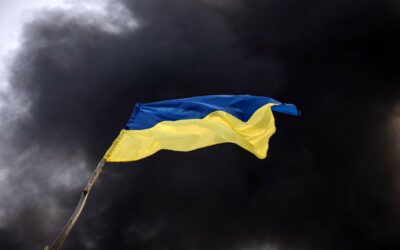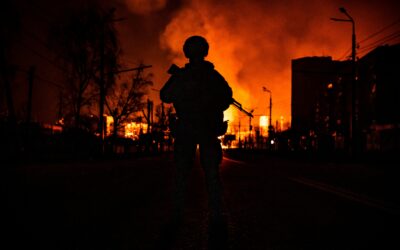
In Future Wars, Drone Weapons With Minds of Their Own
SUBSCRIBER+EXCLUSIVE BRIEFING — Drone weapons are part of the daily narrative of the war in Ukraine – from Russia’s use of Iranian drones against infrastructure […] More
Susan Williams’ book, Spies in the Congo, provides a well-researched and detailed history of the efforts of the Office of Strategic Services, America’s first strategic intelligence agency and the forerunner of the CIA, to establish itself in the Congo as well as West Africa. In telling the OSS story, Dr. Williams reveals two other stories as well: She provides a strategic overview of the joint program between the United States, the United Kingdom, and Canada (U.S./UK/CAN) to develop an atomic weapon; and unfolds the story of the Congolese people.
The principal mission of the small OSS team in the Congo was to thwart any German efforts to obtain the high grade uranium ore from the Shinkolobwe mine in the Eastern Congo Province of Katanga. The Congo ore regularly graded out at over 65 percent uranium; the other sources in the world graded out at less than one percent. Tons of uranium was needed to create a weapons program and a bomb. The United States was determined to obtain all it needed from the Congo and at the same time deny German attempts to secure any Congolese uranium. The actual acquisition of the uranium ore was not an OSS function; that was accomplished by the U.S. Military, the State Department, and the Foreign Economic Administration.
The book does an excellent job of placing the OSS Congo effort in the broader context of the Allied effort to disrupt the German atomic program. The Allies made this disruption a priority using intelligence collection, sabotage, commando raids, and air bombing raids to destroy German Atomic facilities in Europe. Once Allied troops were ashore in Europe in 1944, division level formations of troops were used to capture German Atomic Facilities and to enable the efforts of special evaluation teams sent to measure what the Germans had achieved.
In 1942, there was ample reason to be concerned about the Congo. The Belgian Company that owned the mine in the Congo had sold over a thousand tons of Congolese ore that had been transported to Europe prior to the war to the Germans. After occupation by the Germans in 1940, there was debate in Belgium about how much to collaborate with the Germans, especially in economic matters. The Allies were certainly aware of this debate given that a Belgian Government and Armed Forces in exile was established in England.
Despite the pro-German sympathies of some in the Belgian Colonial Administration in the Congo, the Belgian Governor General of the Congo, Pierre Ryckmans, acting in concert with the Belgian Government in Exile, permitted the sale and transport to the United States of the Congolese uranium ore. Strong concerns, however, persisted in the U.S. Government, especially in the person of General Leslie Groves the head of America’s Atomic Bomb Program—The Manhatten Project—until late in the war that the Germans might have either their own line of acquisition or were making use of corruption and smuggling to obtain uranium from the Congo.
The book, working from declassified OSS flies as well as memoirs and interviews, shows the strengths, weaknesses, and growing pains of the OSS as it becomes a worldwide agency in a wartime environment. Some of the OSS officers had a real talent for intelligence work. Others, despite their patriotism and desire to serve, simply did not. One of the many strengths of the book is the author’s ability to sketch out the backgrounds and character of the members of the OSS team generating in the reader a keen interest in them beyond the Congo mission. The author wisely chose to devote some time at the end of the book to carry the story forward, answering the question of what happened to the OSS team after the war.
The difficulties of transport, communications, logistics, and health encountered by the OSS team trying to get set up in the Congo will resonate with anyone who has served in Africa in any capacity. The book demonstrates the OSS team overcame these difficulties and established an effective collection network of sources. Once established in West Africa and in the Congo, there were issues of coordination with the British, the U.S. State Department, and U.S. Military as well as the Belgian authorities. Some of these organizations were of great assistance to OSS; some less so. Often it was a matter of personalities and trust, as opposed to formal roles and missions.
The book shows that the Congolese uranium that was present in Europe when the war broke out ended up in German hands. The uranium in the Congo was obtained by the Americans. Those outcomes, however logical they may seem now, were not a sure thing in 1942. The effort to ensure Allied acquisition of Congolese uranium and to prevent German acquisition was of critical strategic value to the Allies.
Dr. Williams acknowledges that the U.S./UK/CAN Atomic program had great scientists and an unmatched ability to mobilize science and industry to develop an atomic weapon. She makes the case however, that allied possession of thousands of tons more uranium than the Germans or the Japanese possessed, particularly of such an extraordinarily high grade, gave the allied research effort an overwhelming and decisive competitive advantage. She notes that war time and cold war secrecy likely played a role in the lack of knowledge about the importance of the massive amounts of Congolese uranium in the war effort.
The book also tells the story of the Congolese people before, during, and after the war. The author describes the systematic abuse of the Congolese people by the Belgians throughout the history of King Leopold’s and Belgian colonial rule. She recounts the heart rendering history of the Congo post war, from Independence in 1960 into this decade. Williams is right to be deeply sympathetic to the Congolese. In this writer’s view, few people in the world have had a worse history inflicted upon them by colonialists, the playout of the cold war in the developing world, and their own post-independence leaders than the Congolese.
Williams has greatly advanced our knowledge of the Allied strategic and atomic effort in the Congo as well the unique role of OSS in Africa. She has also provided excellent background as to why so much of the cold war played out in the Congo. Spies in the Congo is an excellent contribution to the history of intelligence, Africa, World War Two and Atomic Power.
Related Articles

SUBSCRIBER+EXCLUSIVE BRIEFING — Drone weapons are part of the daily narrative of the war in Ukraine – from Russia’s use of Iranian drones against infrastructure […] More

SUBSCRIBER+ EXCLUSIVE ANALYSIS — Iran’s retaliatory strikes against Israel this weekend were both a potentially game-changing, historic first — and an underwhelming response. Historic, because […] More

SUBSCRIBER+EXCLUSIVE INTERVIEW — Ukraine was hit by a fresh round of Russian missile attacks on Thursday, strikes that targeted and damaged the country’s power grid […] More

SUBSCRIBER+ EXCLUSIVE REPORTING — The Israeli drone strike that killed three adult sons (who Israel says were Hamas operatives) and four grandchildren of Hamas’s Qatar-based […] More

BOTTOM LINE UP FRONT – In the spring of 2022, Ukraine beat back a Russian assault on the nation’s capital and punished the invaders on […] More

SUBSCRIBER+EXCLUSIVE — The Ukraine war has reached a “pivotal moment,” a “critical stage,” an “inflection point“ – all phrases used to describe the current situation […] More
Search